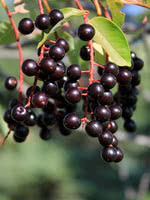Mon-Fri 9am - 5pm Mountain time
Western Chokecherry vs Arrowwood
Viburnum dentatum
Prunus virginiana var. demissa
NOT AVAILABLE THIS SEASON - MIGHT RETURN
SOLD OUT
Arrowwood is a cold hardy, reliable, and vigorous shrub that can easily grow on difficult sites. Featuring an upright, rounded, and multi-stemmed form, this shrub produces creamy white flowers against a backdrop of deep green, serrated foliage.
The flowers give way to dark, blue berries that will attract wildlife to your yard. Depending on the plant, Arrowwood's striking fall color can range from yellow, red to reddish-purple.
Many use Arrowwood for naturalization or mass planting projects but, more commonly, you'll see this simple yet elegant shrub as a shrub border or planted on its own.
Western Chokecherry is a shrub or small tree commonly used for farmstead and field windbreaks.
It produces white flowers in the spring and edible dark purple fruit that matures between September and October. Its cherries are great for making for making jams, jellies or wine, but are not very palatable for raw eating.
Arrowwood Quick Facts
Western Chokecherry Quick Facts
Toxicity: toxic to horses, cattle, etc.)

